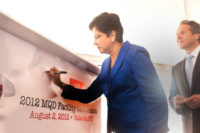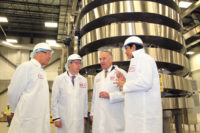As any European dairyman can tell you, if you want more yogurt customers, then come to the United States.
The potential of the U.S. yogurt market was too great for Europe’s Theo Müller Group to ignore. It formed a joint venture with PepsiCo in 2011, broke ground on a yogurt plant in upstate New York in 2012 and began making Greek and conventional yogurt in the United States in 2013.
The yogurts were so successful that the joint venture, named Muller Quaker Dairy, landed on the No. 6 spot of Information Resources Inc.’s 2013 New Product Pacesetters. Chicago-based IRI calls these introductions “the most successful consumer packaged goods” of the year. (Prior to the opening of the New York plant, MQD was shipping product from Europe.) Sales reached $100 million in the 52 weeks ended Feb. 16, 2014.
Müller, with annual sales of about $6.5 billion, had made no bones about its desire to sell yogurt to Americans. Seeing that per capita yogurt sales in the United States are roughly half those in Europe, Müller licked its lips in anticipation of doing business here.
“Expanding our brand from Europe to the U.S. has been a long-time goal,” said company owner Theo Müller in a 2013 statement.
U.S.-based PepsiCo is a global food and beverage giant 10 times as large as its German partner. With annual revenues of $66 billion, it owns 22 brands that generate $1 billion each in sales, including Quaker, Tropicana, Gatorade, Frito-Lay and Pepsi-Cola. PepsiCo has made it known that it wants a portfolio of better-for-you foods and drinks. There was just one hitch: the company had no expertise in manufacturing dairy foods in the United States (though it does have dairy interests in Brazil, Saudi Arabia and Russia).
JV or contract manufacturing?
PepsiCo could have sought a contract manufacturer in the United States to make yogurt under the Quaker name which is well-known, albeit more for oatmeal than for dairy products. No one in the United States had a clue about Theo Müller. So why did PepsiCo partner with Müller?
MQD CEO Johannes Evenblij explained that after looking at many options, “it was clear that Theo Müller Group was the best partner for PepsiCo to enter the still-developing U.S. yogurt market. The Theo Müller Group brings innovative, category-leading products and technology to the partnership with PepsiCo. They have best-in-class dairy manufacturing, are the largest privately owned dairy company in Germany with in-house fruit preparation and have unique products and packaging.”
“The Müller brand reflects the unique essence of the joint venture. Together, Muller Quaker Dairy is bringing two globally revered brands together to introduce our great tasting yogurt to Americans nationwide,” he said.
Perhaps one reason PepsiCo needed to make a splash with yogurt was a change in Americans’ breakfast habits. As the analyst firm Trefis noted, 2013 sales in the Quaker Foods division were flat compared to the previous year.
“Traditional American breakfasts such as oatmeal and sugar cereals are losing customers to quick-service restaurants and dairy products such as yogurt,” Trefis said. Noting that yogurt makes up 40% of the breakfast market and outperforms the entire category, Trefis stated “Quaker will hope to make inroads in the budding yogurt market, in partnership with the Theo Müller Group.”
MQD, however, says the hot cereal category is growing. It cites IRI data showing a 7.8% increase year-to-date.
The Müller Group isn’t the first European yogurt maker to see the potential in the United States. France’s Danone (parent of Dannon) has been selling in the United States for years. Alpina, a dairy company based in Colombia, had a similar revelation. (In 2012, it built a plant in the same industrial park in Batavia, N.Y., as MQD.)
Yogurt has a huge upside for PepsiCo. But it also presents a risk, because the company has little history with dairy foods and beverages. But the relationships that PepsiCo’s soft drink and snack food brands have with retailers give the yogurt joint venture immediate access to grocers’ shelves.
“Dairy is an attractive growth opportunity for PepsiCo. It’s one of the fastest-growing food and beverage categories in the U.S., and per capita consumption remains low,” Evenblij said. “The yogurt category has grown 8% in the last year and is now valued at $6.6 billion. In 2013, yogurt growth was driven primarily by the growth of Greek and Greek-style yogurt and consumer adoption of new indulgent, great-tasting yogurts like Müller yogurt.”
Trefis noted that “the yogurt and sour milk products market is expected to grow by 10% to $9.3 billion by 2018.”
Evenblij said the per capita consumption in the United States grew 4.5% in 2013, but it still trails most other countries where yogurt is eaten. The joint venture “supports PepsiCo’s broader strategy to migrate its portfolio towards attractive high-growth spaces. As part of this strategy, our joint venture is advancing PepsiCo’s strategic intention to grow its ‘good for you’ nutrition-based foods, snacks and beverages portfolio,” he said.
The MQD joint venture “enables us to expand to the U.S. market and is the continuation of our strategy to capitalize on the strong growth of the dairy category around the world,” Evenblij said.
PepsiCo’s dairy bona fides date to the 1980s when it entered the ready-to-drink business in Brazil with a product called Toddynho. In 2009 it formed a joint venture with the Saudi-based dairy company Almarai. And in 2011 PepsiCo acquired Russia’s largest juice and dairy company, Wimm-Bill-Dann.
Welcome to New York
MQD spent $200 million to build a manufacturing plant in Batavia, N.Y., on 82 acres in the Genesee Valley Agri-Business Park in Genesee County. The plant also serves as the company’s production and distribution center. It created 170 jobs and the company expects eventually to employ 180.
All of the production is for the branded product. “Right now, we are focused on building our brand and providing our brand via the retail channel,” Evenblij said.
MQD ships yogurt across the United States. Grocery store customers include Kroger, Safeway, Delhaize, Giant Eagle, Meijer, Publix, Ahold, Walmart and Winn-Dixie. Club store customers include Costco, Sam’s Club and BJ’s.
There are three production lines capable of producing 120,000 cups an hour. At more than 350,000 square feet, there is ample room in the plant to expand. The company said the space can accommodate up to eight lines. At the grand opening of the plant, Theo Müller executive Stefan Müller said, “The systems being deployed at our plant are virtually unknown in the U.S.”
Production of plain and flavored yogurt by U.S. dairies grew 6.8% in 2013 over 2012 to 4.7 billion pounds, according to USDA’s Dairy Products Summary. In 2012, yogurt production was up 3.4% over the previous year. The most yogurt was produced in the Central states (1.9 billion pounds in 2013) followed by the Atlantic region (1.5 billion pounds). The Atlantic region, which includes New York State, has the most yogurt plants (65, compared to 43 in the Central states and 37 in the West).
Yogurt is big business in the Empire State, which is home to Alpina, Chobani and Fage. H.P. Hood, Upstate Niagara Cooperative and Byrne Dairy serve contract manufacturing customers.
In 2012, Governor Andrew Cuomo held a much publicized “yogurt summit” that brought together dairy interests to talk about how to support the yogurt industry. Cuomo and Sen. Charles Shumer advocated for federal funds to support the construction. About $200,000 from the USDA’s Rural Business Enterprise Grant program was used to pave an access road to the yogurt plant.
Products, formats, flavors
MQD hit the United States with three product lines: FrütUp, Corner and Greek Corner. All are made with locally sourced reduced-fat, Grade A milk without artificial flavors, sweeteners or high-fructose corn syrup. Each variety has 140 to 220 calories per serving. For example, a 5.3-ounce cup of Greek Honeyed Apricot has 140 calories, 2 grams of fat, 9 grams of protein and 17 grams of sugar.
FrütUp, a low-fat yogurt topped with a fruit mousse, is the most innovative of the three, at least to U.S. consumers. The mousse, available in eight flavors, can be eaten by itself or swirled into the yogurt, according to the company. A 5.3-ounce cup of mango has 150 calories, 2 grams of fat, 7 grams of protein and 21 grams of sugar.
According to the ingredient statement, the product is made from cultured pasteurized Grade A reduced-fat milk, water, sugar, mango juice from concentrate, mango puree from concentrate, lemon juice from concentrate, dextrose, milk protein concentrate, modified food starch, kosher gelatin, whey protein concentrate, natural flavor, glyceryl-lacto esters of fatty acids, citric acid, beta carotene (for color), sodium citrate and nitrogen. The gelatin is made from tilapia (which also appears on the label) in order to achieve kosher status. A frequently asked question page on the MQD website addresses the reason why this ingredient is used.
The Corner line consists of conventional and Greek yogurt in plastic containers with two compartments that are sealed with metal foil. The larger cup contains the white mass and the smaller cup holds fruit puree or inclusions such as chocolate balls, granola or caramelized almonds.
New Corner flavors combine dark chocolate with cherry, raspberry or pecan granola. Other flavors are strawberry, blueberry, Choco Balls, Crunchy Granola and Crispy Crunch. The Greek flavors are blueberry, peach, pineapple passion fruit, mango, caramelized almonds, blackberry and raspberry, honeyed apricot and strawberry.
“One of the biggest growth opportunities is meeting consumers’ unmet taste needs. We believe yogurt can taste much better,” Evenblij said. In describing the yogurt, he uses the words “a silky texture” and calls the yogurt “delicious and fun to eat.”
Product development
Before the company brings a product to market, it undertakes a formal process that includes looking at broad consumer trends, learning from other categories and markets, enlisting new technologies and listening to core consumers, Evenblij said.
“We are inventing new tastes, textures and flavor combinations for the American consumer,” he said.
“There is a unique opportunity to satisfy unmet consumer taste and convenience needs with Muller Quaker Dairy’s unique offerings. Once people try it, they tell us they love it. We are poised to lead in the years ahead with more innovations.”
Aside from yogurt, the Quaker Oats Co. is working elsewhere in the dairy industry, trying to grow sales, especially those of hard-pressed fluid milk processors. Quaker is working with Dairy Management Inc. on six projects that promote the nutrition and healthy aspects of oats and milk. One of the projects is a promotional partnership with the Milk Processor Education Program (MilkPEP) that encourages consumers to make oatmeal with milk instead of water.
Quaker also is looking for new ways to sell its whole grains. Last year it partnered with the restaurant company Jamba Juice Co. on a fruit smoothie beverage containing 16 grams (one full serving) of whole grains.
To promote its Greek and conventional yogurts to consumers, MQD has used a range of marketing efforts and channels, including TV, digital, print, public relations, social media, FSIs, and in-store activations.
“We are constantly refining our marketing mix to ensure we are talking to our consumers at the right time, through the right mediums and with the right messages,” Evenblij said.
One of those social media channels is Facebook.
“We receive an overwhelming majority of positive Facebook comments from consumers praising Müller yogurt for its unique taste. We have nearly 130,000 Facebook fans even though we have only had a presence for a year.”
MQD’s executive team
Evenblij has led MQD since July 2013. Prior to MQD, Evenblij, who has been at PepsiCo for nine years, led the Foods business for PepsiCo Mexico Foods, which included Quaker and the peanuts category and new foods adjacencies. He held marketing and sales positions at Sabritas, Frito-Lay and Quaker in Mexico, as well as Frito-Lay Latin America. Before joining PepsiCo, Johannes worked for General Electric, Boston Consulting Group and Procter & Gamble.
Evenblij has assembled a multinational team of executives for MQD, calling this diversity one of the company’s strengths. The team includes Kevin Williams (United Kingdom, supply chain), Horst Mueller (Germany, R&D); Steve Gardiner (Canada, sales); Steffen Haydt (Germany, finance); and Brian Hannigan (United States, marketing).
MQD has woven itself into the fabric of the U.S. dairy industry. It is a member of the International Dairy Foods Association (IDFA) and has worked closely with organizations like Dairy Management Inc. (DMI). It is part of the Genesee Chamber of Commerce (in Batavia, N.Y.) and the Genesee County Economic Development Council. Through the joint venture’s parent companies, MQD has a loose affiliation with the National Yogurt Association and the Grocery Manufacturers Association.
For the near future, MQD is “focused on getting [its] facility up and running, making great-tasting yogurt and accelerating our innovation,” Evenblij said.
Long-term trends should help the joint venture succeed. Evenblij points to several consumer and category trends:
- The market for health and wellness consumer packaged goods continues to rapidly grow, he said, “and consumers are more aware than ever of the health benefits of dairy.” Yogurt is a food that offers great taste, nutrition and convenience, he said.
- Protein is gaining recognition as an important part of the U.S. diet. “People know that yogurt is a delicious source of high-quality protein and other nutrients,” he said.
- The yogurt market in the United States is still largely untapped, with consumption here less than half that of western Europeans. “Yogurt still has the feel of being something ‘new’ to Americans in terms of product innovation and variety. In particular, consumers are interested in combining yogurt with other ingredients, such as grains and fruits.”
Evenblij calls himself “a true yogurt lover” who grew up understanding how yogurt can be “an all-day food.” He eats it for dessert when he visits his family in the Netherlands.
“Müller yogurt is both delicious and fun to eat. We are poised to lead in the years ahead with more innovations,” he said.
A dairy heritage dating to 1896
The Theo Müller Group (the German name is “Unternehmensgruppe Theo Müller”) is a holding company headquartered in Luxembourg, with annual sales of nearly 5 billion Euros (about $6.5 billion).
The brand started in Bavaria, Germany, where Ludwig Müller founded a dairy farm in 1896. Today, Ludwig Müller’s grandson Theo owns the business. In 1971, Theo took over his father’s dairy in the Bavarian town of Aretsried, which had just four employees. Today, the company has 21,000 employees worldwide. Müller yogurt is a top-selling brand across Europe and it is widely known across Europe for its dairy products.
The Theo Müller Group is a global food business. Subsidiaries and brands include Müller, Wiseman, Weihenstephan, Sachsenmilch and Kaserei Loose. It manufactures butter, UHT milk, lactose powder and whey protein. The holding company also owns a packaging firm (Optipack), a logistics firm (Culina) and a fruit processing firm (Müller Naturfarm). The businesses are run out of Germany and Luxembourg.
The holding company also owns HK Food Group. This group’s brands (Homann, Nadler and Livio) are active in the chilled gourmet salad, sauces and fish specialties segments in Germany.
Müller runs dairy operations in Europe and Israel. German plants are in Aretsried, Leppersdorf and Freising. It has been running a plant in Market Drayton, U.K., since 1992 and entered the yogurt market in 1995 with Müller Corner. In early 2012, Müller bought Robert Wiseman Dairies of England.
On the continent, Müller owns Mlekarna Prgaolatos in Prague, Czech Republic. It has distribution branches in Italy, Netherlands, Romania and Poland. In February 2008, Müller launched products in Israel.
The company calls its milk plant in Leppersdorf “the most modern dairy in Europe.” Since 1994, Müller has invested about 820 million Euro in the plant expansion. It built a bio-ethanol facility that produces 10 million liters of the environmentally friendly fuel additive from molasses. A gas and steam power plant provides almost all the heat and electricity needs. In 2011, it brought a whey processing facility online.











